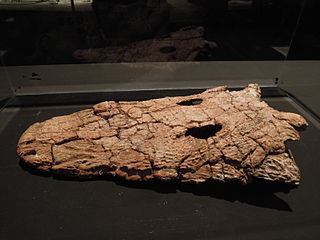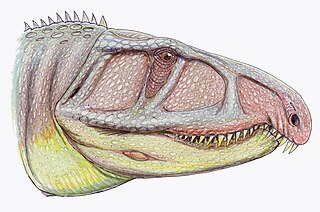Related Research Articles
The Permian is a geologic period and stratigraphic system which spans 47 million years from the end of the Carboniferous Period 298.9 million years ago (Mya), to the beginning of the Triassic Period 251.9 Mya. It is the last period of the Paleozoic Era; the following Triassic Period belongs to the Mesozoic Era. The concept of the Permian was introduced in 1841 by geologist Sir Roderick Murchison, who named it after the region of Perm in Russia.

Lystrosaurus is an extinct genus of herbivorous dicynodont therapsids from the late Permian and Early Triassic epochs. It lived in what is now Antarctica, India, China, Mongolia, European Russia and South Africa. Four to six species are currently recognized, although from the 1930s to 1970s the number of species was thought to be much higher. They ranged in size from that of a small dog to 8 feet long.
In the geologic time scale, the Changhsingian or Changxingian is the latest age or uppermost stage of the Permian. It is also the upper or latest of two subdivisions of the Lopingian Epoch or Series. The Changhsingian lasted from 254.14 to 251.902 million years ago (Ma). It was preceded by the Wuchiapingian and followed by the Induan.

The Induan is the first age of the Early Triassic epoch in the geologic timescale, or the lowest stage of the Lower Triassic series in chronostratigraphy. It spans the time between 251.902 Ma and 251.2 Ma. The Induan is sometimes divided into the Griesbachian and the Dienerian subages or substages. The Induan is preceded by the Changhsingian and is followed by the Olenekian.

Trilophosaurus is a lizard-like trilophosaurid allokotosaur known from the Late Triassic of North America. It was a herbivore up to 2.5 m long. It had a short, unusually heavily built skull, equipped with massive, broad flattened cheek teeth with sharp shearing surfaces for cutting up tough plant material. Teeth are absent from the premaxilla and front of the lower jaw, which in life were probably equipped with a horny beak.

Eryosuchus is an extinct genus of capitosauroid temnospondyl amphibian from the Middle Triassic of northern Russia. It was a very large predator: the largest specimen known could reach up to 3.5 m (11.5 ft) in length, with a skull over 1 m long.

Chroniosuchia is a group of tetrapods that lived from the Middle Permian to Late Triassic in what is now Eastern Europe, Kyrgyzstan, China and Germany. Chroniosuchians are often thought to be reptiliomorphs, but some recent phylogenetic analyses suggest instead that they are stem-tetrapods. They were all rather short limbed with a strong tail and elongated snout, somewhat resembling modern crocodiles. The group is traditionally considered to be a suborder or order of labyrinthodonts. Chroniosuchians likely had ecological niches as riverside predators, and may have been outcompeted by semiaquatic true reptiles such as phytosaurs in the late Triassic. Most forms bore a heavy armour of scutes along the back, possibly for protection against land born predators like therapsids, or to strengthen the axial skeleton for terrestrial locomotion. Indeed, femoral microanatomy of Chroniosaurus suggests that it was amphibious to terrestrial.

Thoosuchus is an extinct genus of basal trematosauroid trematosaurian temnospondyl. Fossils have been found from Russia and date back to the Early Triassic. It is the type genus of the family Thoosuchidae, formerly called the subfamily Thoosuchinae and placed within Benthosuchidae. The benthosuchids were originally composed of the majority of basal trematosaurian forms regarded as the ancestors of the trematosaurids. Although the genus was first named in 1940, material from one species, E. yakovlevi, was originally tentatively referred to Trematosuchus in 1926.
Energosuchus is an extinct genus of rauisuchian. Fossils are present from the upper Karyomayol and lower Synya Formations outcropping along the banks of the Bolshaya Synya river in the Timan-North Urals region in northern European Russia, as well as from the Bukobay Formation in the southern part of Bashkortostan in the southern Urals of European Russia. Both localities date back to the Ladinian stage of the Middle Triassic.

The Santa Rosa Formation is a geologic formation exposed in New Mexico that was deposited in the Carnian Age of the late Triassic Period.
Vritramimosaurus is an extinct genus of large early archosauromorph. Although originally placed in the family Prolacertidae, recent studies on archosauromorph relationships doubt the validity of the family, at least in its broadest sense. Fossils have been found from Early Triassic deposits of the Rassypnaya locality in Orenburg Oblast, Russia. Rassypnaya is located on the Obshchy Syrt, a plateau in the European part of Russia that extends southwest of the Urals toward the Volga River. Vritramimosaurus is similar to the later genus Malutinisuchus, also from Rassypnaya but present in Middle Triassic deposits.
Vonhuenia is an extinct genus of basal archosauriform from the Early Triassic of Russia. Fossils have been found in the Vokhminskaya Formation, along the Vetluga River that are Induan in age, making Vonhuenia one of the earliest archosauriforms.
Guchengosuchus is an extinct genus of erythrosuchid archosauriform from the Early Triassic of China. It is known from a single holotype skeleton called IVPP V 8808, described in 1991 from the lower Ermaying Formation in Shanxi. The lower Ermaying Formation dates back to the Olenekian stage of the Early Triassic, making Guchengosuchus one of the earliest archosauriforms. IVPP V 8808 is a disarticulated skeleton including a partial skull, lower jaw, some vertebrae, a scapula, and forelimb bones. Like some other erythrosuchids, Guchengosuchus has a tall skull with a notch between the premaxilla and maxilla bones of the upper jaw. The ribs of Guchengosuchus each have three heads, a feature also seen in the Russian erythrosuchid Vjushkovia. When it was first described, Guchengosuchus was placed in the suborder Proterosuchia, a group that included the families Erythrosuchidae, Proterosuchidae, and Proterochampsidae and was thought to be closely related to a primitive group of reptiles called Eosuchia. Proterosuchia is now considered a paraphyletic assemblage of basal archosauriforms representing a series of successive branches of stem group archosaurs.

Protorosauria is an extinct polyphyletic group of archosauromorph reptiles from the latest Middle Permian to the end of the Late Triassic of Asia, Europe and North America. It was named by the English anatomist and paleontologist Thomas Henry Huxley in 1871 as an order, originally to solely contain Protorosaurus. Other names which were once considered equivalent to Protorosauria include Prolacertiformes and Prolacertilia.
Coelodontognathus is an extinct genus of reptile from the Early Triassic of European Russia. It was originally described as a procolophonid parareptile in 1967 but was reclassified as a possible trilophosaurid archosauromorph in 2008. The genus includes two species: the type species C. donensis and C. ricovi. C. donensis is known from the holotype PIN 4173/129 and the referred PIN 4173/130, and C. ricovi is known from the holotype PIN 4173/127 and the referred PIN 4173/128, all of which represent dentaries that are housed at the Paleontological Institute, Russian Academy of Sciences. Another dentary, SGU 104/3105, originally referred to C. donensis was reassigned to its own genus and species Vitalia grata by Ivakhnenko, 1973. The fossils have been found at the Donskaya Luka Locality near the village of Sirotinskaya and the Don River in Ilovlinsky District, Volgograd Oblast, from the Lipovskaya Formation of the Gamskii Horizon. Like Coelodontognathus, Vitalia which is known from the same locality was also first identified as a procolophonid and later reclassified as a trilophosaurid. Coelodontognathus and Vitalia are similar to procolophonids in that they have wide teeth but differs from them in that they have tooth roots set deep into the jaws.

Warrenisuchus is an extinct genus of temnospondyl amphibian from the Early Triassic of Queensland, Australia. It belongs to a diverse group of Triassic temnospondyls called Capitosauria. The type species Warrenisuchus aliciae was erected in 2009. W. aliciae was originally described as a species of Parotosuchus in 1988, which is known from other species that have been found in Europe, Africa, and Antarctica. In 2000 it was then assigned to a new genus called Rewanobatrachus along with the newly named species R. gunganj, which was declared the type species of the genus. However, R. gunganj was later reclassified as a species of Watsonisuchus, invalidating the name Rewanobatrachus and requiring that R. aliciae be placed in its own genus, which was named Warrenisuchus. However, several studies suggest that Warrenisuchus aliciae may be a species of Watsonisuchus as well. Unlike most capitosaurs, Warrenisuchus is known from many juvenile skulls less than 4 centimetres (1.6 in) in length.

Uralosaurus is an extinct genus of erythrosuchid archosauriform known from the Middle Triassic Donguz Formation of southeastern European Russia. It contains a single species, Uralosaurus magnus. It was named by Vitalii Georgievich Ochev in 1980 as a species of Erythrosuchus otherwise known from the Triassic of Africa and reassigned to its own genus by Andrey G. Sennikov in 1995.
Vitalia is an extinct genus of reptile from the Early Triassic of European Russia known from the type species V. grata. It is known from the holotype dentary PIN 4173/126 as well as two additional dentaries PIN 1043/627 and 1043/628, all housed at the Paleontological Institute, Russian Academy of Sciences. The type dentary was originally included in the hypodigm of Coelodontognathus donensis named by the notable Russian vertebrate paleontologist Vitaliy Georgiyevich Ochev in 1967. Ivakhnenko (1973) separated the specimen and gave it its own genus and species name in light of the new material, which he named in honor of Ochev. The dentaries of Vitalia were collected at the Donskaya Luka Locality near the village of Sirotinskaya in Ilovlinsky District, Volgograd Oblast, from the Lipovskaya Formation of the Gamskii Horizon. Like Coelodontognathus, Vitalia was originally described as a procolophonid parareptile in 1973, but Arkhangelskii & Sennikov (2008) reclassified the taxon as a possible trilophosaurid archosauromorph. Vitalia is thought to be similar to the possible trilophosaurids Coelodontognathus and Doniceps, both of which are known exclusively from the same locality. Coelodontognathus and Vitalia are similar to procolophonids in that they have wide teeth but differs from them in that they have tooth roots set deep into the jaws.

Counillonia is an extinct genus of dicynodont therapsid from the area of Luang Prabang in Laos, Southeast Asia that lived at around the time of the Permian-Triassic boundary and possibly dates to the earliest Early Triassic. Its type and only known species is C. superoculis. Counillonia was related to the Triassic dicynodonts such as Lystrosaurus and the Kannemeyeriiformes that survived the Permian mass extinction, but it was more closely related to the Permian genus Dicynodon than to either of these lineages. Counillonia may then possibly represent another line of dicynodonts that survived the Permian mass extinction into the Triassic period, depending on its age. The discovery of Counillonia in Laos and its unexpected evolutionary relationships hint at the less well understood geographies of dicynodont diversity across the Permo-Triassic boundary outside of well explored regions like the Karoo Basin in South Africa.

Acratophorus is an extinct genus of dicynodont that lived during the Anisian age of the Middle Triassic-aged Río Seco de la Quebrada Formation in what is now Argentina. The type species, A. argentinensis, was originally placed in the genus Kannemeyeria by Jose Bonaparte in 1966, and later sometimes referred to Vinceria, before being transferred to a new, distinct genus, Acratophorus, in 2021 by Christian Kammerer and Angi Ordoñez. The species Vinceria vieja was also made a synonym of A. argentinensis in 2021. The holotype is PVL 3645, a partial skeleton discovered near a farm house in Puesto Viejo.
References
- ↑ M. V. Surkov (2005). "The first dicynodont from the terminal Lower Triassic of European Russia, with special reference to the evolution of the masticatory apparatus of these therapsids". Paleontological Journal . 39 (1): 72–78.
- ↑ Jörg Fröbisch (2009). "Composition and similarity of global anomodont-bearing tetrapod faunas". Earth-Science Reviews . 95 (3–4): 119–157. Bibcode:2009ESRv...95..119F. doi:10.1016/j.earscirev.2009.04.001.